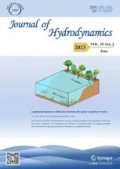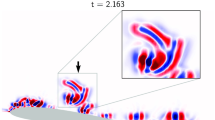Abstract
Fluid kinematics describes the fluid motion without consideration of any force. Classical fluid kinematics adopts Helmholtz velocity decomposition, which is equivalent to Cauchy-Stokes (CS) velocity gradient tensor decomposition. CS decomposes the velocity gradient tensor into a strain-rate (symmetric) tensor and a vorticity (anti-symmetric) tensor. However, several questions arise: (1) since vorticity cannot represent fluid rotation, the vorticity tensor is a mixture of vorticity shear and rigid rotation, (2) since the strain-rate tensor cannot represent fluid shear, the strain-rate tensor is a mixture of stretching and shear, (3) the stretching and shear in the CS decomposition are dependent on the selection of coordinate system and are therefore not Galilean invariant. On the other hand, Liutex is a new physical quantity to represent the rigid fluid rotation and a principal coordinate system can be set up based on Liutex. A principal decomposition of the velocity gradient tensor, or the rotation-stretching-shear decomposition, can be easily carried out in the principal coordinate system with a clear physical meaning, which represents the rigid rotation, stretching (compression) and shear (symmetric and anti-symmetric shear). In the principal decomposition, all elements in three sub-tensors are Galilean invariant and, therefore, the principal decomposition is unique, Galilean invariant and independent of coordinate system. The principal decomposition is then transformed back to the original xyz coordinate system. The Liutex-based principal decomposition creates the new fluid kinematics which is ready for building up new fluid dynamics. Since fluid kinematics is the foundation of the fluid dynamics, the new fluid kinematics could replace the classical fluid kinematics, Helmholtz or CS decomposition, and open a new gate to develop new fluid dynamics especially for vortex science and turbulence research.
Similar content being viewed by others
References
Truesdell C. The kinematics of vorticity (Indiana University Publications Science Seres Nr. 14) [M]. Bloomington, UK: Indiana University Press, 1954.
Batchelor G. Introduction to fluid mechanics [M]. Cambridge, UK: Cambridge University Press, 2000.
Galilei G. Dialogue concerning the two chief world systems [M]. 1632 (Reference Text: Stillman Drake, University of California Press, Berkeley and Los Angeles, 1967 Publisher: Modern Library, New edition (October 2, 2001).
Liu C., Gao Y., Tian S. et al. Rortex-A new vortex vector definition and vorticity tensor and vector decompositions [J]. Physics of Fluids, 2018, 30(3): 35103.
Gao Y., Liu C. Rortex and comparison with eigenvalue-based vortex identification criteria [J]. Physics of Fluids, 2018, 30(8): 85107.
Liu C., Gao Y., Dong X. et al. Third generation of vortex identification methods: Omega and Liutex/Rortex based systems [J]. Journal of Hydrodynamics, 2019, 31(2): 205–223.
Yu Y., Shrestha P., Alvarez O. et al. Correlation analysis among vorticity, Q method and Liutex [J]. Journal of Hydrodynamics, 2020, 32(6): 1207–1211.
Kolář V. Vortex identification: New requirements and limitations [J]. International Journal of Heat and Fluid Flow, 2007, 28(4): 638–652.
Helmholtz H. On the integrals of the hydrodynamic equations corresponding to vortex motions [J]. Journal Für Die Reine Und Angewandte Mathematik, 1858, 55: 22–25(in German).
Lamb H. Hydrodynamics [M]. Cambridge, UK: Cambridge University Press, 1932.
Robinson S. K. Coherent motions in the turbulent boundary layer [J]. Annual Review of Fluid Mechanics, 1991, 23(1): 601–639.
Wang Y., Yang Y., Yang G. et al. DNS study on Vortex and vorticity in late boundary layer transition [J]. Communications in Computational Physics, 2017, 22(2): 441–459.
Epps B. Review of vortex identification methods [C]. 55th AIAA Aerospace Sciences Meeting, Grapevina, Texas, USA, 2017.
Wang Y., Gao Y., Liu C. Letter: Galilean invariance of Rortex [J]. Physics of Fluids, 2018, 30(11): 111701.
Wang Y. Q., Gao Y. S., Xu H. et al. Liutex theoretical system and six core elements of vortex identification [J]. Journal of Hydrodynamics, 2020, 32(2): 197–211.
Liu C., Wang Y. Liutex and third generation of vortex definition and identification for turbulence research [M]. Berlin Heidelberg, Germany: Springer, 2021.
Liu C., Xu H., Cai X. et al. Liutex and its applications in turbulence research [M]. Cambiedge, USA: Academic Press, 2020.
Liu C., Gao Y. Liutex-based and other mathematical, computational and experimental methods for turbulence structure [M]. Sharjah, United Arab Emirates: Bentham Science Publishers, 2020.
Zhou Y., Clark T. T., Clark D. S. et al. Turbulent mixing and transition criteria of flows induced by hydrodynamic instabilities [J]. Physics of Plasmas, 2019, 26(8): 80901.
Zhou Y. Rayleigh-Taylor and Richtmyer-Meshkov instability induced flow, turbulence, and mixing. I [M]. Physics Reports, 2017, 720–722: 1–136.
Zhou Y. Rayleigh-Taylor and Richtmyer-Meshkov instability induced flow, turbulence, and mixing. II [J]. Physics Reports, 2017, 723–725: 1–160.
Wang Y. Q., Gao Y. S., Liu J. M. et al. Explicit formula for the Liutex vector and physical meaning of vorticity based on the Liutex-Shear decomposition [J]. Journal of Hydrodynamics, 2019, 31(3): 464–474.
Acknowledgments
The author thanks his students and visitors including Yi-qian Wang, Xiang-rui Dong, Yi-sheng Gao, Jian-ming Liu, Pan-pan Yan, Wen-qian Xu, Yong-hua Yan, Yi-fei Yu, Sita Charkrit, Pushpa Threstha, Charles Nottage, Oscar Alverez, Vishwa Patel, Dalal Almutairi, Xuan Trieu. The author also thanks his collaborators including Hongyi Xu, Xiao-shu Cai, Hua-shu Dou. The author is grateful to Prof. Lian-di Zhou for countless discussions about the vortex definition. This work was mainly supported by the Department of Mathematics of University of Texas at Arlington as the author is the full-time professor in UTA and all students and visitors were housed by UTA. The author is grateful to Texas Advanced Computing Center (TACC) for providing computation hours.
Author information
Authors and Affiliations
Corresponding author
Additional information
Biography: Chaoqun Liu, Male, Ph. D., Professor
Rights and permissions
About this article
Cite this article
Liu, C. New fluid kinematics. J Hydrodyn 33, 395–399 (2021). https://doi.org/10.1007/s42241-021-0037-5
Received:
Revised:
Accepted:
Published:
Issue Date:
DOI: https://doi.org/10.1007/s42241-021-0037-5



